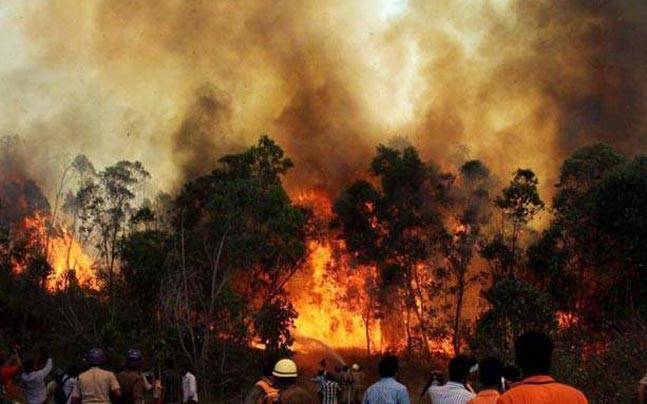I Set Fire To The Mountains
By Aparajita Sengupta
03 May, 2016
Countercurrents.org

Although I was not born there nor lived there long-term, I always thought of myself as a daughter of Uttarakhand. Ever since my first trek in the Garhwal Himalayas when I was seven, the mountains have been the home I go to inside my head. For years, it has been my sanctuary, sometimes in reality, but much more often psychologically. I have gone to the mountains in my times of trouble; pain, anger and humiliation often became easier to handle if I closed my eyes and smelt the musty forest floors, or felt with my fingers the thousand details on the sides of a mountain road. The curl of the fern around my finger, the texture of the lichen, the crumble of the dried pine needles in my fist as they died their fragrant death are memories that I have leaned upon in heartbreak, in loneliness, in loss and in the throes of childbirth.
My parents and many of their friends were frequent hikers and photographers, and to this day, the Garhwal and Kumaon Himalayas are not merely a travel destination but a religion to them. As I was growing up in a cramped house of two rooms in a Kolkata neighborhood, I did not have access to any playgrounds, but the vibrant mountain-going culture in our family kept me breathing. Not only did my own family travel, they were also constantly in touch with other friends going to the mountains, sharing everything from photographs to experiences to travel gear. Sunday evenings often meant hours spent in a dark room with transparency slides projected from hand-cranked projectors on our white-washed walls. There were intense sessions on the names of mountain peaks and their views from particular locations; Trishul, Nandadevi, Nandaghunti, Neelkanth, Panchchuli were names that became familiar to my ears by the time I was eight or nine years old.
The actual trips were exhilarating, filled with the wonder, excitement and adventure that is possible only in low-cost travel that involves a lot of public transport and cheap places to stay. The rooms happily shared at the end of exhausting days, the lovely local meals smelling of wood-fire, the little houses with the enormous hearts in them, furry mountain dogs-- everything about the mountains filled up my little soul with deep happiness. But the beauty of the Himalayas came into my heart and stayed there like a pain. Anyone who has loved the Himalayas will tell you that this love is too much to bear, that it is indeed quite painful. It fills your eyes and your head with such visions that no other place in the world will ever touch you in the same way. You might trot across the globe checking off beautiful places on your must-see list, but you cannot forget the magic of the thousand hues of an Uttarakhand evening in the summertime. This place is the reason why I have looked at world-famed locations and felt a little less than satisfied every time.
The earthquake, the ever-expanding construction zones, the endless lines of SUVs carrying tourists, the rising mounds of plastic-- all of these have increased my fears regarding the well-being of Uttarakhand over the years. Although my family did not have a clear environmental sense, traveling was much cleaner 25-30 years ago. We would carry our water in large pots all the way, refilling where we could, because there were no mineral water bottles to be bought; the potato-chips packets had not invaded village stores, and we were always encouraged to carry back or bury whatever trash we produced. On my last trip to Mukteswar, I was deeply troubled by the mound of trash as we entered the town of Bhatelia, the immense ugly concrete houses built by absentee owners, and the tale of independent farmers selling their lands and becoming care-takers for these houses. We traveled as we try to do these days, carrying our own water, picking up our trash, eating local food, but wondering all the while if we should just let the mountains be. I still saw the mountains of my childhood standing tall, the wind still sweeping over the pines, all the beautiful details of the rocks and the roots and the leaves on the road-side, walked with my daughter in the same sun-dappled mountain paths, and felt that maybe this paradise still lives. As the fire started raging, so did I inwardly, so angry that people might be doing this intentionally. Then I felt a cold fear that it might be my own life, filled with so many things I do not need, that creates the wood mafia. It is my own consumption that dictates that the mountains burn. Am I not burning my own paradise?
I remember that I had seen the first ice in my life at the edge of the Tamosha river. It was a thin white crystal-clear lining that crumbled as I touched it. Looking up from the river, I saw in the incredibly green valley topped with the soaring Swargarohini peak, my mother smiling and waving at her daughters from the front of the Har ki Dun bungalow. The fire is raging in my head every night now, as I wonder if the river of my dreams is running black with blind, blind greed.
Aparajita Sengupta lives and works on a two-acre natural farm near Santiniketan, West Bengal, growing most of the food that her family eats with the help of her husband. Their farm, Smell of the Earth (https://www.facebook.com/SmellOfTheEarth), is focused on growing chemical-free food from native seeds without expensive external inputs, and hopes to spread the message about self-sustaining natural farming. Smell of the Earth does not have any permanent employees or external funding.

